

The Long Game: Brilliant Visual Essays on the Only Secret to Creative Success, from Leonardo da Vinci to Marie Curie. By Maria Popova Why showing up day in and day out without fail is the surest way to achieve lasting success.

“Expect anything worthwhile to take a long time,” a wise woman once said — a seemingly simple observation that is among the 7 most important things I’ve learned in the many years of doing what I do. What’s New in Evernote Web Clipper. Capture articles to read later The Evernote Web Clipper will automatically detect the article on a page and create a beautiful rendering of it inside your Evernote account.

You can expand or shrink the selection using the grab bars. Clip simplified articles Enjoy a better reading experience on your favorite blogs and news sources. The simplified article option clears away everything but the content so you can read it now without distractions or save it to Evernote for later browsing. Bookmark your favorites Want to remember a site without clipping the entire page? Take screenshots in your browser. What Is Love? Famous Definitions from 400 Years of Literary History. By Maria Popova “Love has nothing to do with what you are expecting to get — only with what you are expecting to give — which is everything.”

After those collections of notable definitions of art, science, and philosophy, what better way to start a new year than with a selection of poetic definitions of a peculiar phenomenon that is at once more amorphous than art, more single-minded than science, and more philosophical than philosophy itself? Gathered here are some of the most memorable and timeless insights on love, culled from several hundred years of literary history — enjoy. Kurt Vonnegut, who was in some ways an extremist about love but also had a healthy dose of irreverence about it, in The Sirens of Titan: A purpose of human life, no matter who is controlling it, is to love whoever is around to be loved. Legendary Harvard Psychologist Jerome Bruner on the Art of “Effective Surprise” and the 6 Essential Conditions of Creativity.
By Maria Popova “Passion, like discriminating taste, grows on its use.

You more likely act yourself into feeling than feel yourself into action.” How Long It Takes to Form a New Habit. By Maria Popova Why magic numbers always require a grain of empirical salt.
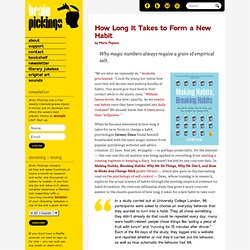
“We are what we repeatedly do,” Aristotle proclaimed. “Could the young but realize how soon they will become mere walking bundles of habits, they would give more heed to their conduct while in the plastic state,” William James wrote. But how, exactly, do we rewire our habits once they have congealed into daily routines? Einstein on Why We Are Alive. By Maria Popova The meaning of human existence in five lines.
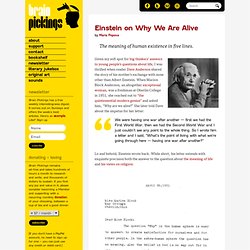
Given my soft spot for big thinkers’ answers to young people’s questions about life, I was thrilled when reader Dave Anderson shared the story of his mother’s exchange with none other than Albert Einstein. When Marion Block Anderson, an altogether exceptional woman, was a freshman at Oberlin College in 1951, she reached out to “the quintessential modern genius” and asked him, “Why are we alive?” She later told Dave about the impetus for her letter: We were having one war after another — first we had the First World War, then we had the Second World War and I just couldn’t see any point to the whole thing.
Lo and behold, Einstein wrote back. The Life and Death of Mountains. A Short Guide to a Happy Life: Anna Quindlen on Work, Joy, and How to Live Rather Than Exist. David Foster Wallace on Writing, Death, and Redemption. By Maria Popova “You don’t have to think very hard to realize that our dread of both relationships and loneliness … has to do with angst about death, the recognition that I’m going to die, and die very much alone, and the rest of the world is going to go merrily on without me.”

On May 21, 2005 David Foster Wallace took the podium at Kenyon College and delivered the now-legendary This Is Water, one of history’s greatest commencement addresses — his timeless meditation on the meaning of life and the grueling work required in order to stay awake to the world rather than enslaved by one’s own self-consuming intellect. It included this admonition:
The Art of Looking: What 11 Experts Teach Us about Seeing Our Familiar City Block with New Eyes. By Maria Popova “Attention is an intentional, unapologetic discriminator.
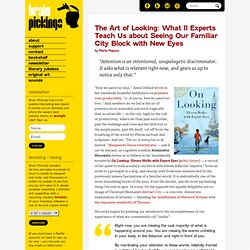
It asks what is relevant right now, and gears us up to notice only that.” “How we spend our days,” Annie Dillard wrote in her timelessly beautiful meditation on presence over productivity, “is, of course, how we spend our lives.” And nowhere do we fail at the art of presence most miserably and most tragically than in urban life — in the city, high on the cult of productivity, where we float past each other, past the buildings and trees and the little boy in the purple pants, past life itself, cut off from the breathing of the world by iPhone earbuds and solipsism. David Foster Wallace on Writing, Death, and Redemption. December 18, 1988: Joseph Brodsky Gives the Greatest Commencement Address of All Time.
By Maria Popova “Of all the parts of your body, be most vigilant over your index finger, for it is blame-thirsty. A pointed finger is a victim’s logo.” The Baloney Detection Kit: Carl Sagan’s Rules for Bullshit-Busting and Critical Thinking. By Maria Popova Carl Sagan was many things — a cosmic sage, voracious reader, hopeless romantic, and brilliant philosopher.
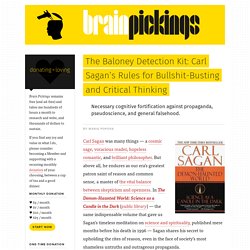
But above all, he endures as our era’s greatest patron saint of reason and common sense, a master of the vital balance between skepticism and openness. In The Demon-Haunted World: Science as a Candle in the Dark (public library) — the same indispensable volume that gave us Sagan’s timeless meditation on science and spirituality, published mere months before his death in 1996 — Sagan shares his secret to upholding the rites of reason, even in the face of society’s most shameless untruths and outrageous propaganda.
Debunking the Myth of the 10,000-Hours Rule: What It Actually Takes to Reach Genius-Level Excellence. By Maria Popova How top-down attention, feedback loops, and daydreaming play into the science of success.
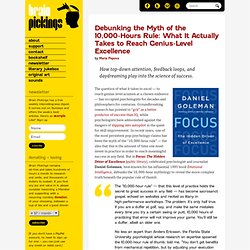
The question of what it takes to excel — to reach genius-level acumen at a chosen endeavor — has occupied psychologists for decades and philosophers for centuries. Groundbreaking research has pointed to “grit” as a better predictor of success than IQ, while psychologists have admonished against the dangers of slipping into autopilot in the quest for skill improvement. In recent years, one of the most persistent pop-psychology claims has been the myth of the “10,000-hour rule” — the idea that this is the amount of time one must invest in practice in order to reach meaningful success in any field. But in Focus: The Hidden Driver of Excellence (public library), celebrated psychologist and journalist Daniel Goleman, best-known for his influential 1995 book Emotional Intelligence, debunks the 10,000-hour mythology to reveal the more complex truth beneath the popular rule of thumb:
Jack Kerouac’s List of 30 Beliefs and Techniques for Prose and Life. David Ogilvy’s Timeless Principles of Creative Management. By Maria Popova “If you ever find a man who is better than you are — hire him. If necessary, pay him more than you pay yourself.” Advertising legend David Ogilvy endures not only as the original Mad Man, but also as one of modern history’s most celebrated creative leaders in the communication arts. From The Unpublished David Ogilvy (public library) — the same compendium of his lectures, memos, and lists that also gave us Ogilvy’s 10 no-bullshit tips on writing, his endearing memo of praise to a veteran copywriter, and his list of the 10 qualities of creative leaders — comes a chapter titled “Principles of Management,” based on a 1968 paper Ogilvy wrote as a guide for Ogilvy & Mather managers worldwide.
In a section on morale, he admonishes that some companies “have been destroyed by internal politics” and offers seven ways to curtail them: * Though Ogilvy was writing decades before email, the same applies with equal urgency to today’s electronic warfare. Kill grimness with laughter. Einstein on Kindness, Our Shared Existence, and Life’s Highest Ideals. By Maria Popova “Without the sense of fellowship with men of like mind… life would have seemed to me empty.” In times of turmoil, I often turn to one of my existential pillars of comfort: Albert Einstein’s Ideas and Opinions — the definitive collection of the great thinker’s essays on everything from science and religion to government to human nature, gathered under the supervision of Einstein himself.
It’s been a challenging week, one that’s reminded me with merciless acuity the value of kindness and compassion, so I’ve once again turned to Einstein’s timeless “ideas and opinions” on this spectrum of subjects. Brain Pickings. Neurologist Oliver Sacks on memory, plagiarism, and the necessary forgettings of creativity. Why Time Slows Down When We’re Afraid, Speeds Up as We Age, and Gets Warped on Vacation. By Maria Popova “Time perception matters because it is the experience of time that roots us in our mental reality.”
Given my soft spot for famous diaries, it should come as no surprise that I keep one myself. Perhaps the greatest gift of the practice has been the daily habit of reading what I had written on that day a year earlier; not only is it a remarkable tool of introspection and self-awareness, but it also illustrates that our memory “is never a precise duplicate of the original [but] a continuing act of creation” and how flawed our perception of time is — almost everything that occurred a year ago appears as having taken place either significantly further in the past (“a different lifetime,” I’d often marvel at this time-illusion) or significantly more recently (“this feels like just last month!”). Question asked to Atheist which they could not answer. The Secret to Learning Anything: Albert Einstein’s Advice to His Son.
Mark Twain on Plagiarism and Originality: “All Ideas Are Second-Hand” The Science of Beauty. By Maria Popova “Attitudes toward beauty are entwined with our deepest conflicts surrounding flesh and spirit.” “That is the best part of beauty, which a picture cannot express,” Francis Bacon observed in his essay on the subject. A 5-Step Technique for Producing Ideas circa 1939.